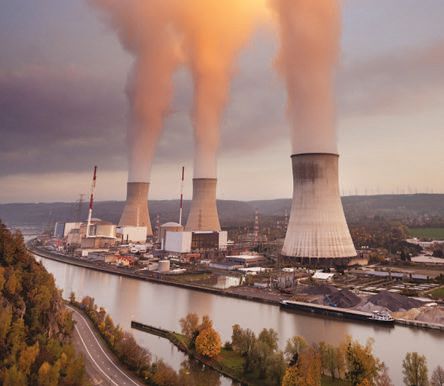10 Questions About Future Technology
Edward P. Salek, CAE, Executive Director | TLT Headquarters Report December 2015
STLE’s new report presents expert answers about industry trends in the next 3-5 years.

Several experts believe nuclear energy could make a comeback in the U.S. as emerging technologies overcome such challenges as waste disposal.
STLE IS IN A UNIQUE POSITION when it comes to tracking trends in the lubricants industry. We have access to the thought-leaders in the field who understand the technology challenges facing the industry worldwide.
Our most recent effort to capitalize on this strength is Trends in Tribology and Lubrication Engineering: Industry Leader Predictions Report. It resulted from a year-long effort to evaluate the impact of changes in industry, technology and the economy on the field. Nearly 1,000 industry experts were surveyed during the course of the research with the goal of tapping into their collective wisdom and insight and drawing conclusions about the future of tribology and lubrication engineering.
One value of the report is to confirm by consensus some of the conventional thinking heard at technical conferences or published in the trade press. Take, for example, the report’s conclusion that companies in the manufacturing sector will continue to look for lubricants that enable them to operate with less downtime and maintenance, increase automation, replace and/or reduce usage of fossil fuels and utilize new engineered material composites.
But the report also goes beyond these consensus issues and poses questions about the interplay between tribology, lubricants and technological change that are intriguing and often contrarian. Here’s a sample of 10 such queries:
1. While traditional fossil fuels will remain a mainstay in the short term, especially with the drop in crude oil prices, will natural gas become the bridge to alternative energies of the future or could solar-based energy become the dominant technology if scientific advancements are able to solve current limitations?
2. Could nuclear energy make a comeback in the U.S. and other nations that limit its usage? Several experts think so because of new plant designs and materials selection that are capable of overcoming challenges such as waste disposal and political opposition.
3. Will demands for more advanced technology cause lubricants development to become a tech industry? As one respondent remarked, “Increases in productivity and efficiency encompass many of the other trends (i.e., reduced costs/consumption, recycling, etc.) and will force lubricant and metalworking fluid chemistries to become more complex.”
4. On the other hand, might technology become a limiting factor instead of an enabler? Manufacturers may shift production to foreign countries in order to realize efficiencies of business. However, this may impede developments as employees in “lower-cost” locations might lack the specialized knowledge to use advanced lubricants.
5. What will drive innovation in the transportation sector? Government regulations will keep tribologists busy working on teams striving to meet mandatory emissions and fuel efficiency targets in the U.S.
6. How long will the good times last for tribologists working on these environmentally friendly and fuel efficient engines? Maybe not all that long, several people noted, because the commercialization of electric-powered vehicles could sharply decrease the demand for lubrications and new lubricant formulations.
7. If electric vehicles did dominate the transportation landscape, might the reduction in use of fossil fuels be offset by a new series of environmental challenges? Consider, for example, that the production of electricity creates pollution itself and, as one participant pointed out, “the disposal of batteries is an environmental hazard.”
8. Cleaner, lighter and more dangerous? Survey participants confirm that new vehicles will be lighter and quieter. While these may be desirable outcomes from an efficiency and design perspective, they might also result in safety challenges. For example, “The use of lightweight components may compromise crash worthiness if not properly designed.”
9. Downsides in manufacturing as well? The development of automated technologies has created new efficiencies, including less downtime, greater accuracy and less waste. However, participants point out that fewer “eyes and ears” on a process could make manufacturing companies regret the change. As one participant put it, “When machinery starts to go, experienced humans are usually the first to catch it.”
10. What technology could fundamentally change the lubrication industry by 2035? Coatings, which offer the potential for efficiency through reduced friction, increased service life, and greater reliability of components.
The 20-page Industry Leader Predictions Report is a companion to STLE’s “2014 Report on Emerging Issues and Trends.” Download a free digital copy of both at
www.stle.org.
 You can reach Certified Association Executive Ed Salek at esalek@stle.org
You can reach Certified Association Executive Ed Salek at esalek@stle.org.